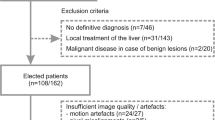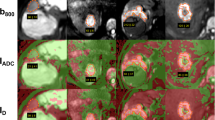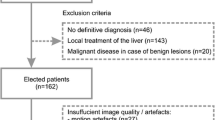Abstract
Purpose
This study aims to investigate three different image processing methods on quantitative parameters of IVIM sequence, as well as apparent diffusion coefficients and simple perfusion fractions, for benign and malignant liver tumors.
Materials and methods
IVIM images with 8 b-values (0–1000 s/mm2) and 1.5 T MRI scanner in 16 patients and 3 healthy people were obtained. Next, the regions of interest were selected for malignant, benign, and healthy liver regions (50, 56, and 12, respectively). Then, the bi-exponential equation of the IVIM technique was fitted with two segmented fitting methods as well as one full fitting method (three methods in total). Using the segmented fitting method, diffusion coefficient (D) is fixed with a mono-exponential equation with b-values that are greater than 200 s/mm2. The perfusion fraction (f) can then be calculated by extrapolating, as the first method, or fitting simultaneously with the pseudo-diffusion coefficient (D*) as the second method. In the full fitting method, as the third method, all IVIM parameters were obtained simultaneously. The mean values of parameters from different methods were compared in different grades of lesions.
Results
Our results indicate that the image processing method can change statistical comparisons between different groups for each parameter. The D value is the only quantity in this technique that does not depend on the fitting process and can be used as an indicator of comparison between studies (P < 0.05). The most effective method to distinguish liver lesions is the extrapolated f method (first method). This method created a significant difference (P < 0.05) between the perfusion parameters between benign and malignant lesions.
Conclusion
Using extrapolated f is the most effective method of distinguishing liver lesions using IVIM parameters. The comparison between groups does not depend on the fitting method only for parameter D.




Similar content being viewed by others
Data availability
The datasets generated during and analysed during the current study are available from the corresponding author on reasonable request.
References
Ni P, Lin Y, Zhong Q, Chen Z, Sandrasegaran K, Lin C (2016) Technical advancements and protocol optimization of diffusion-weighted imaging (DWI) in liver. Abdom Radiol 41:189–202
Wang YXJ, Huang H, Zheng C-J, Xiao B-H, Chevallier O, Wang W (2021) Diffusion-weighted MRI of the liver: challenges and some solutions for the quantification of apparent diffusion coefficient and intravoxel incoherent motion. Am J Nucl Med Mol Imaging 11:107
Chandarana H, Taouli B (2010) Diffusion and perfusion imaging of the liver. Eur J Radiol 76:348–358
Kanematsu M, Goshima S, Watanabe H, Kondo H, Kawada H, Noda Y et al (2012) Diffusion perfusion MR imaging of the liver: practice, challenges, and future. Magn Reson Med Sci 11:151–161
Stocker D, Hectors S, Bane O, Vietti-Violi N, Said D, Kennedy P et al (2021) Dynamic contrast-enhanced MRI perfusion quantification in hepatocellular carcinoma: comparison of gadoxetate disodium and gadobenate dimeglumine. Eur Radiol 31:9306–9315
Xu P-J, Yan F-H, Wang J-H, Shan Y, Ji Y, Chen C-Z (2010) Contribution of diffusion-weighted magnetic resonance imaging in the characterization of hepatocellular carcinomas and dysplastic nodules in cirrhotic liver. J Comput Assist Tomogr 34:506–512
Le Bihan D (2019) What can we see with IVIM MRI? Neuroimage 187:56–67
Zhu L, Cheng Q, Luo W, Bao L, Guo G (2015) A comparative study of apparent diffusion coefficient and intravoxel incoherent motion-derived parameters for the characterization of common solid hepatic tumors. Acta Radiol 56:1411–1418
Ying ML, Xiao WW, Xu SL, Shu JE, Pan JF, Fu JF et al (2016) Value of intravoxel incoherent motion diffusion-weighted imaging in differential diagnosis of benign and malignant hepatic lesions and blood perfusion evaluation. Zhonghua Gan Zang Bing Za Zhi = Zhonghua Ganzangbing Zazhi = Chinese J Hepatol 24:840–845
Iima M (2021) Perfusion-driven Intravoxel incoherent motion (IVIM) MRI in oncology: applications, challenges, and future trends. Magn Reson Med Sci 20:125
Shen N, Zhao L, Jiang J, Jiang R, Su C, Zhang S et al (2016) Intravoxel incoherent motion diffusion-weighted imaging analysis of diffusion and microperfusion in grading gliomas and comparison with arterial spin labeling for evaluation of tumor perfusion. J Magn Reson Imaging 44:620–632
Doblas S, Wagner M, Leitao HS, Daire J-L, Sinkus R, Vilgrain V et al (2013) Determination of malignancy and characterization of hepatic tumor type with diffusion-weighted magnetic resonance imaging: comparison of apparent diffusion coefficient and intravoxel incoherent motion–derived measurements. Invest Radiol 48:722–728
Wang X, Chen X-Z, Shi L, Dai J-P (2019) Glioma grading and IDH1 mutational status: assessment by intravoxel incoherent motion MRI. Clin Radiol 74:651.e7-651.e14
Luo M, Zhang L, Jiang X, Zhang W (2017) Intravoxel incoherent motion diffusion-weighted imaging: evaluation of the differentiation of solid hepatic lesions. Transl Oncol 10:831–838
Luo M, Zhang L, Jiang X-H, Zhang W-D (2017) Intravoxel incoherent motion: application in differentiation of hepatocellular carcinoma and focal nodular hyperplasia. Diagnostic Interv Radiol 23:263
Tosun M, Onal T, Uslu H, Alparslan B, Çetin AS (2020) Intravoxel incoherent motion imaging for diagnosing and staging the liver fibrosis and inflammation. Abdom Radiol 45:15–23
Cui Y, Li C, Liu Y, Jiang Y, Yu L, Liu M et al (2020) Differentiation of prostate cancer and benign prostatic hyperplasia: comparisons of the histogram analysis of intravoxel incoherent motion and monoexponential model with in-bore MR-guided biopsy as pathological reference. Abdom Radiol 45:3265–3277
Klauss M, Mayer P, Maier-Hein K, Laun FB, Mehrabi A, Kauczor H-U et al (2016) IVIM-diffusion-MRI for the differentiation of solid benign and malign hypervascular liver lesions—evaluation with two different MR scanners. Eur J Radiol 85:1289–1294
Chevallier O, Zhou N, Cercueil J, He J, Loffroy R, Wáng YXJ (2019) Comparison of tri-exponential decay versus bi-exponential decay and full fitting versus segmented fitting for modeling liver intravoxel incoherent motion diffusion MRI. NMR Biomed 32:e4155
Wurnig MC, Donati OF, Ulbrich E, Filli L, Kenkel D, Thoeny HC et al (2015) Systematic analysis of the intravoxel incoherent motion threshold separating perfusion and diffusion effects: proposal of a standardized algorithm. Magn Reson Med 74:1414–1422
Li YT, Cercueil J-P, Yuan J, Chen W, Loffroy R, Wáng YXJ (2017) Liver intravoxel incoherent motion (IVIM) magnetic resonance imaging: a comprehensive review of published data on normal values and applications for fibrosis and tumor evaluation. Quant Imaging Med Surg 7:59
Heiken JP (2007) Distinguishing benign from malignant liver tumours. Cancer Imaging 7:S1
Huang H, Zheng C, Wang L, Che-Nordin N, Wáng YXJ (2021) Age and gender dependence of liver diffusion parameters and the possibility that intravoxel incoherent motion modeling of the perfusion component is constrained by the diffusion component. NMR Biomed 34:e4449
Yoon JH, Lee JM, Yu MH, Kiefer B, Han JK, Choi BI (2014) Evaluation of hepatic focal lesions using diffusion-weighted MR imaging: comparison of apparent diffusion coefficient and intravoxel incoherent motion-derived parameters. J Magn Reson Imaging 39:276–285
Watanabe H, Kanematsu M, Goshima S, Kajita K, Kawada H, Noda Y et al (2014) Characterizing focal hepatic lesions by free-breathing intravoxel incoherent motion MRI at 3.0 T. Acta Radiol 55:1166–1173
Wang M, Li X, Zou J, Chen X, Chen S, Xiang W (2016) Evaluation of hepatic tumors using intravoxel incoherent motion diffusion-weighted MRI. Med Sci Monit Int Med J Exp Clin Res 22:702
Namimoto T, Nakagawa M, Kizaki Y, Itatani R, Kidoh M, Utsunomiya D et al (2015) Characterization of liver tumors by diffusion-weighted imaging: comparison of diagnostic performance using the mean and minimum apparent diffusion coefficient. J Comput Assist Tomogr 39:453–461
Wang X, Cao M, Chen H, Ge J, Suo S, Zhou Y (2020) Simplified perfusion fraction from diffusion-weighted imaging in preoperative prediction of IDH1 mutation in WHO grade II–III gliomas: comparison with dynamic contrast-enhanced and intravoxel incoherent motion MRI. Radiol Oncol 54:301
Kakite S, Dyvorne HA, Lee KM, Jajamovich GH, Knight-Greenfield A, Taouli B (2016) Hepatocellular carcinoma: IVIM diffusion quantification for prediction of tumor necrosis compared to enhancement ratios. Eur J Radiol Open 3:1–7
Wáng YXJ, Wang X, Wu P, Wang Y, Chen W, Chen H et al (2019) Topics on quantitative liver magnetic resonance imaging. Quant Imaging Med Surg 9:1840
Dyvorne HA, Galea N, Nevers T, Fiel MI, Carpenter D, Wong E et al (2013) Diffusion-weighted imaging of the liver with multiple b values: effect of diffusion gradient polarity and breathing acquisition on image quality and intravoxel incoherent motion parameters—a pilot study. Radiology 266:920
Barbieri S, Donati OF, Froehlich JM, Thoeny HC (2016) Comparison of intravoxel incoherent motion parameters across MR imagers and field strengths: evaluation in upper abdominal organs. Radiology 279:784–794
Acknowledgements
The present study was derived from an M.Sc. thesis (Research Project Code: 981808) which has been supported by the Deputy of Research and Technology of Mashhad University of Medical Sciences, Mashhad, Iran.
Author information
Authors and Affiliations
Corresponding author
Ethics declarations
Conflict of interest
All authors have no potential conflicts of interest.
Ethical standards
This study was approved by our Institutional Review Board and informed consent was IR.MUMS.MEDICAL.REC.1399.464.
Additional information
Publisher's Note
Springer Nature remains neutral with regard to jurisdictional claims in published maps and institutional affiliations.
Supplementary Information
Below is the link to the electronic supplementary material.
Rights and permissions
Springer Nature or its licensor (e.g. a society or other partner) holds exclusive rights to this article under a publishing agreement with the author(s) or other rightsholder(s); author self-archiving of the accepted manuscript version of this article is solely governed by the terms of such publishing agreement and applicable law.
About this article
Cite this article
Bagheri, M., Ghorbani, F., Akbari-Lalimi, H. et al. Histopathological graded liver lesions: what role does the IVIM analysis method have?. Magn Reson Mater Phy 36, 565–575 (2023). https://doi.org/10.1007/s10334-022-01060-0
Received:
Revised:
Accepted:
Published:
Issue Date:
DOI: https://doi.org/10.1007/s10334-022-01060-0




